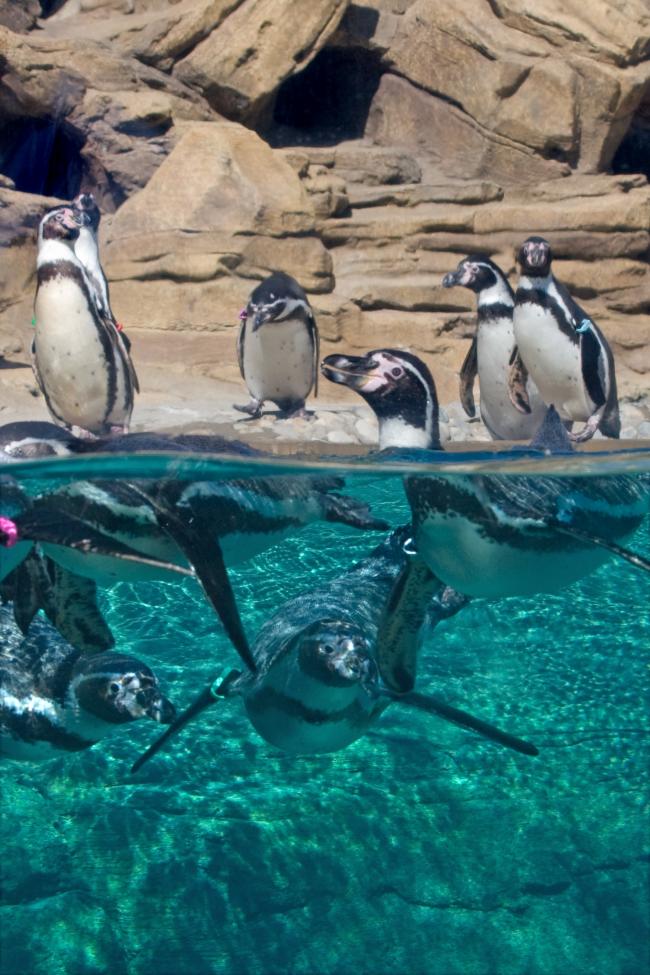New penguin exhibit to open in May
Wed, 04/08/2009
A new colony of Humboldt penguins was introduced yesterday for the first time to Woodland Park Zoo’s new penguin exhibit, which opens to the public on May 2.
The 20 tuxedoed birds waddled outdoors onto the beach and naturally did what penguins in the wild do, they went swimming.
The penguins, 10 males and 10 females, arrived three weeks ago from five other zoos and aquariums. As part of the zoo’s excellent animal care program for its animals and new arrivals, the penguins had been in quarantine in the interior enclosure of the new exhibit. The birds range in ages 1 to 20 years old and moved from Brookfield Zoo (Chicago), SeaWorld (San Diego), Rosamond Gifford Zoo (Syracuse, NY), Saint Louis Zoo and Aquarium of Niagara (Niagara Falls, NY).
Zoo animal management staff will continue to monitor the birds closely as they acclimate to their new setting. Celine Pardo, a penguin keeper at Woodland Park Zoo, has been working with the birds since they arrived. “Watching the penguins take their first steps outdoors was truly remarkable,” said Pardo. “They took to the water immediately, and showed off their innate prowess of diving and “flying” underwater. It was very rewarding to see them behave just like wild penguins.”
The all new exhibit transports zoo visitors to the desert coast of Punta San Juan – home of the largest colony of wild Humboldt penguins in Peru. The 17,000-square-foot naturalistic home features shoreline cliffs, viewable entrances to nesting burrows, rocky tide pools, crashing waves and a beach.
With special windows and acrylic walls, dramatic vantage points will offer guests nose-to-beak viewing as penguins splash, dive and swoop underwater. Other observations for visitors may include seeing the birds feeding, preening, and squabbling over nesting sites during the breeding season (February/March) – much like they do on the Peruvian shores in the wild.
The penguin exhibit is built sustainably including: geothermal energy; an innovative filtration system that will save three million gallons of water and nearly 22,000 kilowatt hours of energy per year – the equivalent of saving 24 million pints of drinking water, and heating five, new two-bedroom townhouses each year; containment of and recycled stormwater runoff to conserve tap water and prevent pollution of our surrounding streams and other natural water sources.
“ The new population of 20 penguins arrived at Woodland Park through recommendations by the Humboldt penguin Species Survival Plan (SSP) to ultimately form a breeding colony,” explained Mark Myers, a curator at Woodland Park Zoo. “Not all of the penguins will have recommendations to breed, but our plan to grow the colony also involves acquiring more penguins through the SSP.”
Species Survival Plans are cooperative breeding programs that work to ensure genetic diversity and demographic stability in North American zoos and aquariums. The Humboldt penguin SSP is among 39 SSPs that Woodland Park Zoo participates in, including the western lowland gorilla, ocelot, Komodo dragon and red panda. Under the auspices of AZA, SSPs also involve a variety of other collaborative conservation activities such as research, public education, reintroduction and field projects.
People do not usually think of penguins as a desert species. Unlike their ice and snow-dwelling Antarctic cousins, Humboldt penguins inhabit hot, dry coastlines in Peru and Chile. They live on rocky mainland shores, especially near cliffs, or on coastal islands.
Humboldt penguins have a body made to swim. Using their strong wings, they “fly” underwater, usually just below the surface, at speeds of up to 20 miles per hour. They steer with their feet and tail.
As conservation ambassadors, the endangered penguins at the zoo will help heighten awareness about their plight in the wild. It is estimated that only 12,000 endangered Humboldt penguins survive in the wild. Overfishing of anchovies – the penguin’s primary food source – and other human activities, such as the harvesting of guano deposits, which penguins rely on to build nests in, pose the greatest threats to their survival.
Woodland Park Zoo is committed to conserving Humboldt penguins by supporting the Humboldt Penguin Conservation Center at Punta San Juan, breeding endangered penguins through the Species Survival Plan, and encouraging visitors to choose sustainable seafood options.
The penguin exhibit is made possible by public and private support by more than 550 donors, including the King County Park Levy, community fundraising campaigns, The Hugh and Jane Ferguson Foundation, Bill and Melinda Gates Foundation, The Bank of America Charitable Foundation, Seattle City Light and Seattle Public Utilities. It is a part of the zoo’s $14 million penguin-west entry project.


